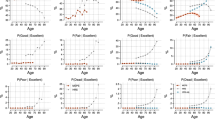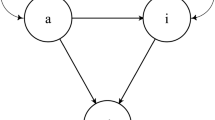Abstract
Multistate life table methods are often used to estimate the proportion of remaining life that individuals can expect to spend in various states, such as healthy and unhealthy states. Sullivan’s method is commonly used when panels containing data on transitions are unavailable and true multistate tables cannot be generated. Sullivan’s method requires only cross-sectional mortality data and cross-sectional data indicating prevalence in states of interest. Such data often come from sample surveys, which are widely available. Although the data requirements for Sullivan’s method are minimal, the method is limited in its ability to produce estimates for subpopulations because of limited disaggregation of data in cross-sectional mortality files and small cell sizes in aggregated survey data. In this article, we develop, test, and demonstrate a method that adapts Sullivan’s approach to allow the inclusion of covariates in producing interval estimates of state expectancies for any desired subpopulation that can be specified in the cross-sectional prevalence data. The method involves a three-step process: (1) using Gibbs sampling to sample parameters from a bivariate regression model; (2) using ecological inference for producing transition probability matrices from the Gibbs samples; (3) using standard multistate calculations to convert the transition probability matrices into multistate life tables.
Similar content being viewed by others
References
Barendregt, J.J., L. Bonneux, and P.J. Van der Maas. 1994. “Health Expectancy: An Indicator for Change?”Journal of Epidemiology and Community Health 48: 482–87.
Cai, L. and J. Lubitz. 2007. “Was There Compression of Disability for Older Americans From 1992 to 2003?”Demography 44: 479–95.
Cai, L., N. Schenker, and J. Lubitz. 2006. “Analysis of Functional Status Transitions by Using a Semi-Markov Process Model in the Presence of Left-Censored Spells.”Journal of the Royal Statistical Society: Series C (Applied Statistics) 55: 477–91.
Chib, S. and E. Greenberg. 1998. “Analysis of Multivariate Probit Models.”Biometrika 85: 347–61.
Crimmins, E.M. and Y. Saito. 2001. “Trends in Healthy Life Expectancy in the United States, 1970–1990: Gender, Racial, and Educational Differences.”Social Science and Medicine 52: 1629–41.
Crimmins, E.M., Y. Saito, and D. Ingegneri. 1997. “Trends in Disability-Free Life Expectancy in the United States, 1970–1990.”Population and Development Review 23: 555–72.
Gelman, A., J.B. Carlin, H.S. Stern, and D.B. Rubin. 1995.Bayesian Data Analysis. Boca Raton, FL: Chapman and Hall/CRC Press.
Hayward, M.D., M. Rendall, and E. Crimmins. 1999. “Evaluating Group Differences in Healthy Life Expectancy: The Estimation of Confidence Intervals for Multistate Life Table Expectancies.” Presented at the annual meeting of the Gerontological Society of America, San Francisco.
Imai, K. and S. Soneji. 2007. “On the Estimation of Disability-Free Life Expectancy: Sullivan’s Method and Its Extension.”Journal of the American Statistical Association 102: 1199–211.
King, G. 1997.A Solution to the Ecological Inference Problem: Reconstructing Individual Behavior From Aggregate Data. Princeton, NJ: Princeton University Press.
Laditka, S.B. and D.A. Wolf. 1998. “New Methods for Analyzing Active Life Expectancy.”Journal of Aging and Health 10: 214–41.
Land, K.C., J.M. Guralnik, and D.G. Blazer. 1994. “Estimating Increment-Decrement Life Tables With Multiple Covariates from Panel Data: The Case of Active Life Expectancy.”Demography 31: 297–319.
Land, K.C. and G.C. Hough, Jr. 1989. “New Methods for Tables of School Life, With Applications to US Data From Recent School Years.”Journal of the American Statistical Association 84: 63–75.
Land, K.C. and R. Schoen. 1982. “Statistical Methods for Markov-Generated Increment-Decrement Life Tables With Polynomial Gross Flow Functions.” Pp. 265–346Multidimensional Mathematical Demography, edited by K.C. Land and A. Rogers. New York: Academic Press.
Lee, M.A. and M.S. Rendall. 2001. “Self-employment Disadvantage in the Working Lives of Blacks and Females.”Population Research and Policy Review 20: 291–320.
Lievre, A., N. Brouard, and C. Heathcoate. 2003. “Estimating Health Expectancies From Cross-Longitudinal Surveys.”Mathematical Population Studies 10: 211–48.
Lynch, S.M. 2007.Introduction to Applied Bayesian Statistics and Estimation for Social Scientists. New York: Springer.
Lynch, S.M. and J.S. Brown. 2005. “ANew Approach to Estimating Life Tables With Covariates and Constructing Interval Estimates of Life Table Quantities.”Sociological Methodology 35: 177–225.
Mathers, C.D. and J-M. Robine. 1997. “How Good is Sullivan’s Method for Monitoring Changes in Population Health Expectancies?”Journal of Epidemiology and Community Health 51: 80–86.
Molla, M.T., D.K. Wagener, and J.H. Madans. 2001. “Summary Measures of Population Health: Methods for Calculating Healthy Life Expectancy.”Healthy People Statistical Notes No. 21. National Center for Health Statistics, Hyattsville, MD.
Palloni, A. 2000. “Increment-Decrement Life Tables.” Pp. 256–72 inDemography: Measuring and Modeling Social Processes, edited by S.H. Preston, P. Heuveline, and M. Guillot. Oxford, England: Blackwell.
Preston, S.H., P. Heuveline, and M. Guillot. 2000.Demography: Measuring and Modeling Social Processes. Oxford, UK: Blackwell.
Rubin, D.B. 1981. “The Bayesian Bootstrap.”Annals of Statistics 9: 130–34.
Schoen, R. 1988.Modeling Multigroup Populations. New York: Plenum.
Singer, B. and S. Spilerman. 1976. “The Representation of Social Processes by Markov Models.”American Journal of Sociology 82: 1–54.
Sullivan, D.F. 1971. “A Single Index of Mortality and Morbidity.”HMSHA Health Reports 86: 347–54.
Wolf, D.A. and S.B. Laditka. 1996. “Stochastic Modeling of Active Life and Its Expectancy.” Paper presented at the annual meeting of REVES, Rome, December 11–13.
Zellner, A. 1962. “An Efficient Method of Estimating Seemingly Unrelated Regressions and Tests for Aggregation Bias.”Journal of the American Statistical Association 57: 348–68.
Author information
Authors and Affiliations
Corresponding author
Rights and permissions
About this article
Cite this article
Lynch, S.M., Brown, J.S. Obtaining multistate life table distributions for highly refined subpopulations from cross-sectional data: A bayesian extension of sullivan’s method. Demography 47, 1053–1077 (2010). https://doi.org/10.1007/BF03213739
Issue Date:
DOI: https://doi.org/10.1007/BF03213739




